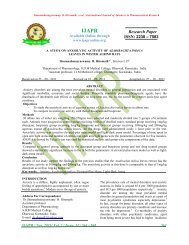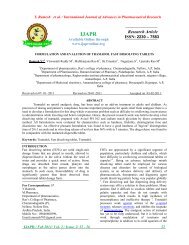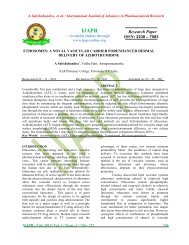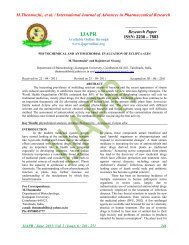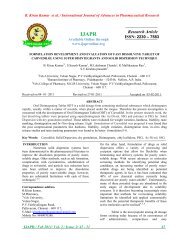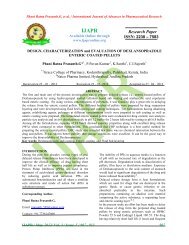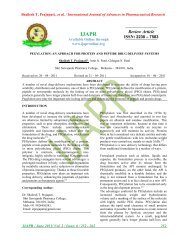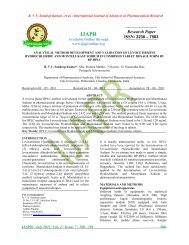ijapr - international journal of advances in pharmaceutical research
ijapr - international journal of advances in pharmaceutical research
ijapr - international journal of advances in pharmaceutical research
Create successful ePaper yourself
Turn your PDF publications into a flip-book with our unique Google optimized e-Paper software.
M.S Latha et al. / International Journal <strong>of</strong> Advances <strong>in</strong> Pharmaceutical Research<br />
Thirty six rats were divided <strong>in</strong>to six groups,<br />
Group I - Normal control<br />
Group II - NDEA control (0.02% NDEA, 2<br />
ml, 5days/week, p.o)<br />
Group III - Silymar<strong>in</strong> (100mg/kg b.w) +<br />
NDEA<br />
Group IV - MEWF (100mg/kg, b.w ) +<br />
NDEA<br />
Group V - MEWF (200mg/kg, b.w) + NDEA<br />
Group VI - MEWF (200 mg/kg) alone<br />
Daily doses <strong>of</strong> silymar<strong>in</strong> and MEWF treatments were<br />
started <strong>in</strong> groups III to V animals 1 week before the<br />
onset <strong>of</strong> NDEA adm<strong>in</strong>istration and cont<strong>in</strong>ued up to<br />
20 weeks. Group VI served as drug control received<br />
MEWF alone for the entire period. The rats were<br />
sacrificed 48 h after the last dose <strong>of</strong> NDEA<br />
adm<strong>in</strong>istration.<br />
2.6 Serum enzyme analysis<br />
Blood was collected from neck blood vessels and<br />
kept for 30 m<strong>in</strong> at 4 0 C. Serum was separated by<br />
centrifugation at 2500rpm at 4 0 C for 15 m<strong>in</strong>.<br />
Quantify<strong>in</strong>g the serum levels <strong>of</strong> aspartate<br />
am<strong>in</strong>otransferase (AST), alan<strong>in</strong>e am<strong>in</strong>otransferase<br />
(ALT) and gamma glutamyl transferase (GGT) by<br />
us<strong>in</strong>g a standard diagnostic kit (Agappe Diagnostic<br />
Ltd., India). Activities <strong>of</strong> these serum enzymes were<br />
measured by us<strong>in</strong>g semi autoanalyzer (RMS, India).<br />
2.7 Tissue analysis<br />
Liver tissue was excised, washed thoroughly <strong>in</strong> icecold<br />
sal<strong>in</strong>e to remove the blood. Then the dissected<br />
livers were cut <strong>in</strong>to separate portions for biochemical<br />
assays and immunohistochemical exam<strong>in</strong>ation.<br />
2.7.1 Biochemical assays<br />
Ten percent <strong>of</strong> homogenate was prepared <strong>in</strong> 0.1M<br />
Tris HCl buffer (pH – 7.4). The homogenate was<br />
centrifuged at 3000 rpm for 20 m<strong>in</strong> at 4 o C and the<br />
supernatant was used for the estimation <strong>of</strong><br />
glutathione-S-transferase (GST), glutathione<br />
reductase (GR), glutathione peroxidase (GPx) and<br />
total prote<strong>in</strong>.<br />
GST (EC 2.5.1.18) activity was determ<strong>in</strong>ed from the<br />
rate <strong>of</strong> <strong>in</strong>crease <strong>in</strong> conjugate formation between<br />
reduced glutathione and CDNB (16). GR (EC<br />
1.6.4.2) activity was assayed at 37 o C and 340 nm by<br />
follow<strong>in</strong>g the oxidation <strong>of</strong> NADPH by GSSG (17).<br />
GPx (EC 1.11.1.9) activity was determ<strong>in</strong>ed by<br />
measur<strong>in</strong>g the decrease <strong>in</strong> GSH content after<br />
<strong>in</strong>cubat<strong>in</strong>g the sample <strong>in</strong> the presence <strong>of</strong> H2O2 and<br />
NaN3 (18). Prote<strong>in</strong> content <strong>in</strong> the tissue was<br />
determ<strong>in</strong>ed us<strong>in</strong>g bov<strong>in</strong>e serum album<strong>in</strong> (BSA) as the<br />
standard (19).<br />
2.7.2 Immunohistochemical analysis<br />
Immunohistochemical analysis <strong>of</strong> the two cancer<br />
markers, namely proliferat<strong>in</strong>g cell nuclear antigen<br />
(PCNA) and Cycl<strong>in</strong> D1 were conducted.<br />
Tissue sections were deparaff<strong>in</strong>ised <strong>in</strong> three changes<br />
<strong>of</strong> xylene at 60 o C for 10m<strong>in</strong> each and hydrated<br />
through a graded series <strong>of</strong> alcohol. For antigen<br />
retrieval evaluation, slides were placed <strong>in</strong> citrate<br />
buffer (pH 6.0) for three cycles <strong>of</strong> 5 m<strong>in</strong> each <strong>in</strong> a<br />
microwave oven. The sections were then allowed to<br />
cool to room temperature and then r<strong>in</strong>sed with 1x tris<br />
buffered sal<strong>in</strong>e (TBS), and treated with 0.3% H2O2 <strong>in</strong><br />
water for 10 m<strong>in</strong> to block endogenous peroxidase<br />
activity. Non specific b<strong>in</strong>d<strong>in</strong>g was blocked with 3%<br />
BSA <strong>in</strong> room temperature for 1 h. Subsequently the<br />
primary antibody was applied at predeterm<strong>in</strong>ed<br />
dilutions (PCNA antibody diluted 1:500 / Cycl<strong>in</strong><br />
D1antibody diluted 1:80) with 1% BSA <strong>in</strong> PBS for<br />
overnight at 4 o C. After this <strong>in</strong>cubation washed thrice<br />
<strong>in</strong> PBS and <strong>in</strong>cubated with anti-mouse horseradish<br />
peroxidase for 45 m<strong>in</strong>. After triplicate wash<strong>in</strong>g with<br />
PBS, sections were <strong>in</strong>cubated for 30 m<strong>in</strong> with<br />
streptavid<strong>in</strong>–HRP complex. Then washed with PBS<br />
and <strong>in</strong>cubated for 5–10 m<strong>in</strong> <strong>in</strong> a solution <strong>of</strong><br />
diam<strong>in</strong>obenzid<strong>in</strong>e (6 mg/10mL 50mM Tris–HCl, pH<br />
7.6) conta<strong>in</strong><strong>in</strong>g 0.01% H2O2. Countersta<strong>in</strong><strong>in</strong>g was<br />
performed with hematoxyl<strong>in</strong>. Images were taken at<br />
orig<strong>in</strong>al magnification <strong>of</strong> 100× ( Motic AE 21,<br />
Germany and Moticam 1000 camera).<br />
2.8 Statistical analysis<br />
Results were expressed as mean ± S.D and all<br />
statistical comparisons were made by means <strong>of</strong> oneway<br />
ANOVA test followed by Tukey’s post hoc<br />
analysis and p-values less than or equal to 0.05 were<br />
considered significant.<br />
3. RESULTS<br />
3.1 Serum enzyme analysis<br />
The serum levels <strong>of</strong> AST, ALT, and GGT <strong>in</strong> group II<br />
were significantly (p ≤ 0.05) elevated by the<br />
adm<strong>in</strong>istration <strong>of</strong> NDEA, when compared to normal<br />
control. The treatment <strong>of</strong> MEWF at a dose <strong>of</strong> 100 and<br />
200 mg/kg showed a significant decrease (p ≤ 0.05)<br />
<strong>in</strong> AST, ALT, and GGT (Fig.1). Standard control<br />
drug, Silymar<strong>in</strong> at a dose <strong>of</strong> 100 mg/kg also<br />
prevented the elevation <strong>of</strong> serum enzymes. Treatment<br />
with MEWF at 200 mg/kg and Silymar<strong>in</strong> exhibited a<br />
protection <strong>of</strong> 98% and 80.7% <strong>in</strong> AST levels, 97% and<br />
88% <strong>in</strong> ALT levels and 98.2% and 84% <strong>in</strong> GGT<br />
levels, respectively.<br />
3.2 Liver morphology<br />
Fig.2 shows the morphological variations <strong>of</strong> rat livers<br />
<strong>in</strong> different experimental groups. NDEA treated rat<br />
IJAPR / Dec. 2012/ Vol. 3 /Issue. 12 / 1322 – 1330 1324



